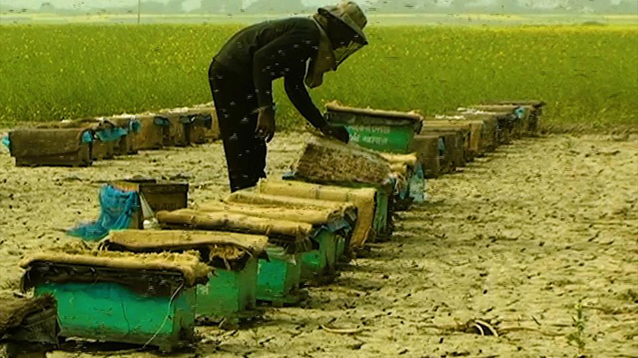Thursday, April 25, 2024
News and Views from the Global South
Beekeeping in Chalanbeel Gains Popularity among Pabna, Sirajganj Farmers
- From time immemorial, honey is popularly known as the best cure for hundreds of diseases.
Yet, we rarely allow bees to make hives, in which they store the honey they produce from nectar of flowers, around our houses.
However, it appears that the trend has changed, or at least that is the case in the Chalanbeel areas of Pabna and Sirajganj over the last decade, where bees can now make their hives near the crop fields as beekeeping or apiculture gains popularity among the farmers.
Apiculture helps to meet the growing demand for honey as more and more people are learning of its goodness, and also increasing the crop production as bees are a great aid in pollination.
During winter, mustard fields see a high yield of honey collected from the hives and also a bumper harvest of mustard by the boon of the practice of apiculture in the region, according to agriculture officials.
This year, between 2500 to 3000 metric tons of honey is likely to be collected from around 50 thousand special bee boxes set up in over 60 thousand hectares of mustard field in the Chalanbeel regions of Pabna and Sirajganj, said Md Khoyer Uddin, additional deputy director of Department of Agriculture Extension (DAE), Pabna.

During winter, mustard fields see a high yield of honey collected from the hives and also a bumper harvest of mustard by the boon of the practice of apiculture in the region, according to agriculture officials. Photo: Star
This is the highest honey producing zone across the country, he also said.
“Mustard farmers earlier used pesticide to make mustard field free from pest attack, now they have left using pesticide in mustard field due to the bee keeping, which increases production by 15 to 20 percent,” the DAE deputy director of Pabna added.
Bees collect the nectar from mustard flowers when they fully blossom in the fields, and process the nectar into honey in the honeycomb-laden bee boxes. The bee keepers then collect the honey from the boxes. The process also facilitates the transfer of pollens among mustard flowers, giving rise to a high yield.

Bees collect the nectar from mustard flowers when they fully blossom in the fields, and process the nectar into honey in the honeycomb-laden bee boxes. Photo: Star
“Around 800 beekeepers from different parts of the country rush to the Chalanbeel region of Pabna and Sirajganj in winter to get the vast yellow mustard field for collecting honey,” Jahangir Alam Modhu, president of a bee keepers’ association in northern region, told The Daily Star.
The beekeepers set their bee boxes on the crop fields from mid-November targeting to collect honey till May, he also said adding that besides mustard, honey is also produced from the nectar of flowers of other winter crops including kalo jeera among others.
“Mustard field is suitable for honey production than any other winter crops. I have set 300 boxes in one bigha field in Noubaria village under Vangura upazila in Pabna couple of weeks ago and got 2000 kilogrammes of honey,” said Md Aslam Sardar, a bee keeper in the area.
This story was originally published by The Daily Star, Bangladesh

 Print
Print



